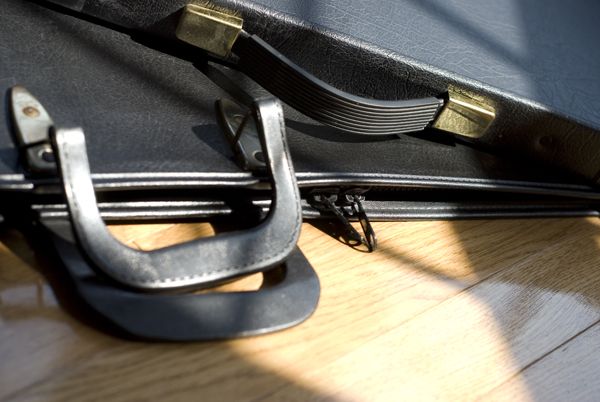What Kind of Things Do Art Schools Want in Your Potfolio

Why Less Is More than
The first and nigh important rule of a groovy art portfolio is to use as few images as possible to show the best piece of work you can do. A common error beginners make is putting all of their work into their portfolio. At the beginning, this might exist because you only have enough completed work to brand a small portfolio, but as your body of piece of work grows, it's of import to make your portfolio concise. Yous need to get the message underlying your style as an artist across quickly. A bloated portfolio that doesn't communicate the strengths of your body of work immediately and effectively will result in missed opportunities with prospective collectors, curators and gallerists. Some other problem with larger portfolios is that whatever below-average piece of work in your portfolio will lower the quality of the entire collection of work. People will gauge your ability based on the worst work in your portfolio. Having a single bad slice can turn your portfolio from an asset to a liability and cost y'all opportunities. This is why you should keep information technology simple; showing six to ten images of your very best work is a not bad place to start.
Your Work, Specialized
When people look at your portfolio, there is an expectation that yous are showing them your latest body of work and that the themes and fashion you nowadays are indicative of your oeuvre. Nearly successful artists accept a niche, a particular style or expanse of expertise. You might be able to produce everything from still lifes to portraits to landscapes, and it is great that y'all can work outside any one condolement zone. But it'south far amend to be the best at one matter rather than boilerplate at everything. Make a portfolio that showcases the kind of work yous do best. Show why you lot're work deserves pride of place in a buyer's home or gallery rep'south wall.
Do Your Market Inquiry
Now that you lot know the basics, it's fourth dimension to size up the work that is trending around you lot. Effort to find other people who have a body of work similar to yours and take a look at the portfolios on their website. Your goal should be to make your portfolio at least as good as the portfolios that you find. If you find a competitor with a great portfolio, bookmark it and compare it to yours afterward to see if you have achieved your goal.
Dos and Don'ts
- Do use high-quality images. Always utilise high-quality and high-resolution photographs for your portfolio. If you use watermarks on your images, brand sure they are not distracting. It'due south easy for a watermark to completely ruin the visual impact of an prototype.
- Don't use huge files in your portfolio. While you need a very big file size for printing, if you use print resolution files for your portfolio, it will accept longer to download and may not display correctly on some devices. (Hint: At the moment, the Hd standard of 1920 × 1080 pixels is a great size for files that volition be accessed digitally. Somewhen, the 4k standard of 4096 × 2160 pixels will supervene upon it.)
- Practise wait at your portfolio on a wide diversity of devices. You want your portfolio to look great on computers, tablets, and phones. Ask your friends to look on their devices and let you know if they have any bug viewing the work you send.
- Do watch people looking at your portfolio. Which images do they spend the most time on? If your best work is at the end of your portfolio, effort moving information technology to the front. If people are struggling to navigate your digital portfolio, change the formatting to get in easier to view.
- Don't have 2 images with the exact same subject. Although you don't desire an inconsistent and confusing portfolio, yous also want to avoid duplicates. Try to avert having whatsoever two images that are too similar to each other or characteristic the same subject.
- Create several portfolios. Artists work in many dissimilar media and focus on more than than ane subject matter. That can result in several bodies of work. Create portfolios that are focused on each one so you can show them off to targeted audiences or interested buyers.

Website Portfolios
Your website should be the first thing people observe when they search for you lot online. The torso of piece of work you lot are showcasing should either be on the home page of your website or merely one click away from the landing page. Use meta tags on your portfolio page to describe the subject matter of your portfolio in general terms and so that people searching for those things will have a risk of finding your portfolio in an image search — contemporary mural painting or mixed media portraiture for example. You can employ a diverseness of gallery plugins for your website, but the primal thing is to brand it easy to use and intuitive for the viewer. Once you lot take your artworks on view on your site, picket people looking at them. If they struggle to navigate, use a different presentation or alter the settings to make information technology more intuitive.
Cloud Portfolios
Use deject services similar Dropbox and Google Drive to ship prospective buyers or galleries the body of work you are virtually interested in getting sold and or put on view. Past using a deject service, you can speedily create a binder containing the images you want your prospective client to see and send it to them instantly without changing anything on your website or web portfolio page. (Hint: If you transport someone a link to a folder with a cloud service you lot tin can correct mistakes or alter your portfolio fifty-fifty after you have sent it.)
PDF Portfolios
PDF portfolios are the happy center between an online portfolio and a print portfolio. Yous tin keep a PDF of your best piece of work on your tablet or phone to show people when they ask you what kind of art you specialize in. This way you ever take a professionally presented portfolio in your pocket. It'southward easy to make a PDF of your portfolio. You can use Adobe Acrobat or you can catechumen a spider web folio, a Word certificate, or a Powerpoint to a PDF. PDFs are likewise ready to impress, and yous can label the works with the pertinent information a heir-apparent or gallerist would be interested in — size, materials, etc. If you accept a swell PDF portfolio that you have had success with showing clients in person, why non use it as the basis for a professionally printed portfolio?
Print Portfolios
 Originally, portfolios were selections of artworks that you would show a gallery owner or collector in person, just now people oftentimes take their piece of work available to view simply online. For artists, this is not as ideal equally having a studio visit where the collector tin run into the work in person, but it'south definitely an attracting first pace. When online portfolios first became available, having an online portfolio made you stand out because it showed that you were different. At present that everyone has an online portfolio, you tin can stand up out past having a professionally printed portfolio or itemize once once again. It costs more, but information technology gives you an opportunity to show someone your portfolio in person. While you can electronic mail a customer a link to your online collection for free, showing someone your work professionally presented in a print portfolio tin can really ready you apart.
Originally, portfolios were selections of artworks that you would show a gallery owner or collector in person, just now people oftentimes take their piece of work available to view simply online. For artists, this is not as ideal equally having a studio visit where the collector tin run into the work in person, but it'south definitely an attracting first pace. When online portfolios first became available, having an online portfolio made you stand out because it showed that you were different. At present that everyone has an online portfolio, you tin can stand up out past having a professionally printed portfolio or itemize once once again. It costs more, but information technology gives you an opportunity to show someone your portfolio in person. While you can electronic mail a customer a link to your online collection for free, showing someone your work professionally presented in a print portfolio tin can really ready you apart.
Review Your Portfolio at Least Once a Yr
If you are decorated, you might not realize how long it has been since you concluding looked at your torso of work in its entirety. When yous first make your portfolio, put a reminder in your agenda for the adjacent twelvemonth to remind yourself to update your portfolio. A great idea is to always update your portfolio in the outset week of a new year or the week of your birthday. Updating your portfolio is a chance to assess your progress and see how much you have improved.
Outstanding Art Comes First
A great portfolio is simply a reflection of the great piece of work it contains. The Artistic Fine art Form: Marker-Making & Drawing video download teaches you how to loosen up and add free energy and expressiveness to your artwork. The result volition be a torso of work with your own exciting style that has a through-line that volition connect your individual pieces into a cohesive whole. Savour!
This article was excerpted from the 2017 Artist's and Graphic Designer's Marketplace. Original commodity written by Luke McLaughlin.
Source: https://www.artistsnetwork.com/art-business/outstanding-art-portfolio/